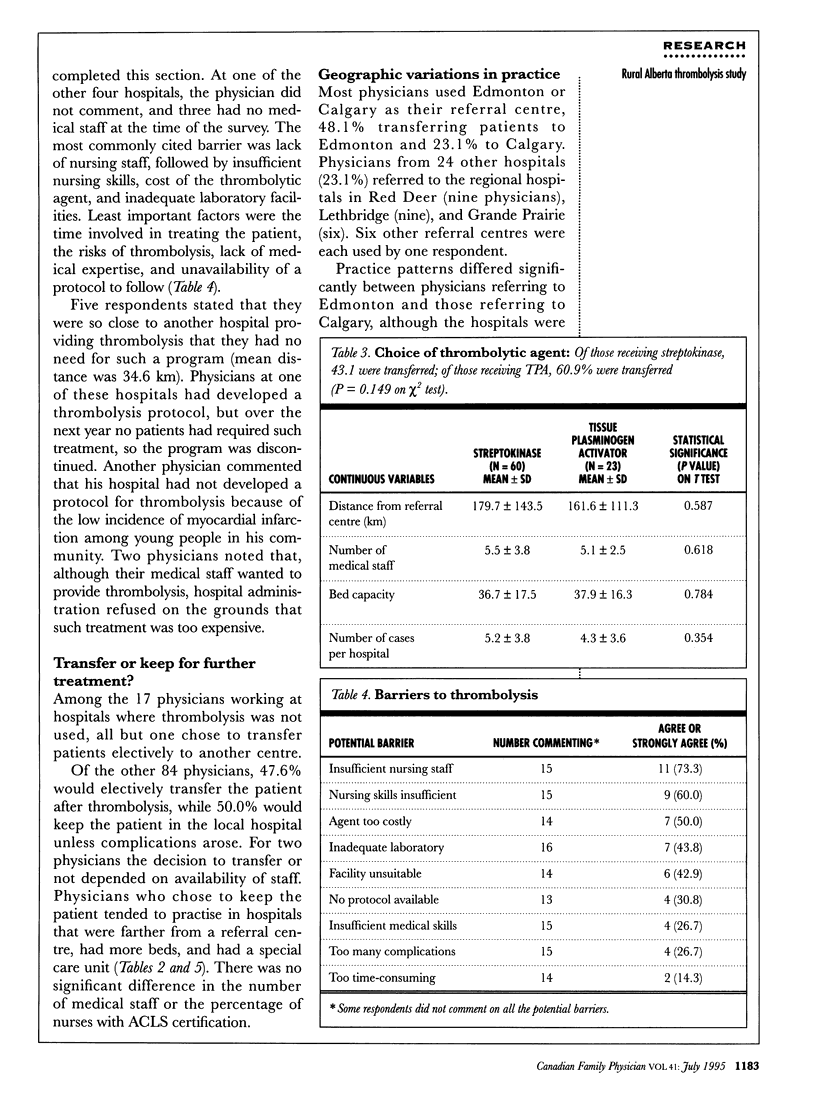Abstract
OBJECTIVE: To determine current practice patterns for managing acute myocardial infarction in rural Alberta, particularly to examine the availability of thrombolytic therapy. DESIGN: Mailed questionnaire based on a clinical vignette. SETTING: All 104 acute care hospitals in rural Alberta with fewer than 100 beds. PARTICIPANTS: The Chief of Staff at each hospital. MAIN OUTCOME MEASURES: Proportion of hospitals providing thrombolytic therapy, choice of thrombolytic agent, rates of elective transfer after thrombolysis, and barriers preventing universal use of thrombolytic therapy. RESULTS: Questionnaires were completed by 101 physicians. Three hospitals had no medical staff. Thrombolytic therapy was available in 80.8% of the hospitals. Hospitals that did not offer thrombolysis were smaller (average bed capacity 21.9 versus 37.7, P < 0.001), had fewer medical staff (average number 2.4 versus 5.5, P < 0.001), and had fewer nurses holding Advanced Cardiac Life Support certification (P = 0.015) than hospitals providing thrombolysis. Physicians identified inadequate nursing resources as the greatest barrier to providing thrombolysis. Of physicians using thrombolysis, 71.4% chose streptokinase. Half of the physicians preferred elective transfer after the procedure. CONCLUSIONS: Thrombolytic therapy for acute myocardial infarction is standard practice in small hospitals in Alberta.
Full text
PDF







Selected References
These references are in PubMed. This may not be the complete list of references from this article.
- An international randomized trial comparing four thrombolytic strategies for acute myocardial infarction. The GUSTO investigators. N Engl J Med. 1993 Sep 2;329(10):673–682. doi: 10.1056/NEJM199309023291001. [DOI] [PubMed] [Google Scholar]
- Bellinger R. L., Califf R. M., Mark D. B., Weber R. A., Collins P., Stone J., Phillips H. R., 3rd, German L., Stack R. S. Helicopter transport of patients during acute myocardial infarction. Am J Cardiol. 1988 Apr 1;61(10):718–722. doi: 10.1016/0002-9149(88)91054-5. [DOI] [PubMed] [Google Scholar]
- Buchalter M. B., Suntharalingam G., Jennings I., Hart C., Luddington R. J., Chakraverty R., Jacobson S. K., Weissberg P. L., Baglin T. P. Streptokinase resistance: when might streptokinase administration be ineffective? Br Heart J. 1992 Nov;68(5):449–453. doi: 10.1136/hrt.68.11.449. [DOI] [PMC free article] [PubMed] [Google Scholar]
- Fromm R. E., Jr, Hoskins E., Cronin L., Pratt C. M., Spencer W. H., 3rd, Roberts R. Bleeding complications following initiation of thrombolytic therapy for acute myocardial infarction: a comparison of helicopter-transported and nontransported patients. Ann Emerg Med. 1991 Aug;20(8):892–895. doi: 10.1016/s0196-0644(05)81433-7. [DOI] [PubMed] [Google Scholar]
- Henry R., deGruy F. Intravenous streptokinase for treatment of acute myocardial infarction in small hospitals. J Fam Pract. 1988 Apr;26(4):438-9, 442. [PubMed] [Google Scholar]
- Hutten-Czapski P. Thrombolytic therapy for myocardial infarction. Treatment introduced in northern Ontario. Can Fam Physician. 1993 May;39:1071–1074. [PMC free article] [PubMed] [Google Scholar]
- Lee H. S., Cross S., Davidson R., Reid T., Jennings K. Raised levels of antistreptokinase antibody and neutralization titres from 4 days to 54 months after administration of streptokinase or anistreplase. Eur Heart J. 1993 Jan;14(1):84–89. doi: 10.1093/eurheartj/14.1.84. [DOI] [PubMed] [Google Scholar]
- McNamara C. A., Burket M. W., Brewster P. S., Leighton R. F., Fraker T. D., Jr Comparison of thrombolytic therapy for acute myocardial infarction in rural and urban settings. Am J Med. 1987 Jun;82(6):1095–1101. doi: 10.1016/0002-9343(87)90210-5. [DOI] [PubMed] [Google Scholar]
- Thompson J. M., Ratcliff M. J. Use of Emergency Outpatient Services in a Small Rural Hospital: A look at a rural hospital in Alberta. Can Fam Physician. 1992 Oct;38:2322–2331. [PMC free article] [PubMed] [Google Scholar]


